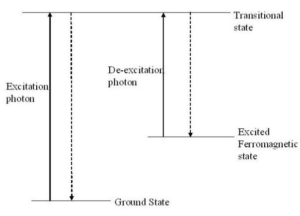A magnetic field is a force field created via magnetic dipoles and moving electric charges. Thus, it exerts a force on the other moving charges and magnetic dipoles nearby. It is also important to note that a magnetic field is a vector quantity, and it has both a direction and magnitude. This article discusses the photomagnetic effect as well as the Faraday effect,
Magnetic Field Lines
A magnetic field line or lines of forces show the strength of a magnet and the direction of the magnetic force. Michael Faraday discovered this in order to visualise the magnetic field.
Let us discuss something more about the Faraday Effect
The Faraday Effect
The Faraday Effect refers to the rotating magnetic field’s plane of polarisation of a light beam. The English scientist Michael Faraday observed this effect in the year of 1845 when he was researching the influence of a magnetic field on the plane-polarised light waves. Plane-polarised light waves mean when light waves vibrate in two different planes around right angles, and thereafter, ordinary light is passed through some substances that eliminate vibration in one plane.
When the light route and the direction of the applied magnetic effect are parallel, he discovered that the plane of vibration rotates. The Faraday effect can be observed in a wide range of solids, liquids, and gases. The strength of the magnetic field, the nature of the transmitting substance, and Verdet’s constant, which is a property of the transmitting substance, its temperature, and the frequency of light, all influence the magnitude of rotation.
Now let us understand the magnetic effect of electric current through a simple experiment.
Suppose there is a straight current-carrying conductor, vertically hung and an electric current that flows from north to south. In such a situation, the magnetic field direction will be clockwise. However, if the same current is flowing from south to north with the same conductor, then the magnetic field, in this case, would be anti-clockwise.
Thus, the direction of the magnetic field in the case of electric current with a straight conductor can be represented with the help of a Right-Hand Thumb Rule.
The Right-Hand Thumb Rule
Let us assume that you are holding a current-carrying conductor straight in your right hand with the thumb pointing towards the current direction. Now wrap your fingers around the conductor in the direction of the magnetic field lines.
Thus, the right-hand thumb rule is also known as the Maxwell corkscrew rule. So, when taking this example by driving a corkscrew in the current direction, that direction is known as the magnetic field direction.
Since we now know about the mechanism of magnetism and the Faraday effect, let us understand photomagnetism.
What is Photomagnetism?
Photomagnetism or photomagnetic effect is where the material acquires properties of ferromagnetism in response to light. The model for this phenomenon is a light-induced electron transfer, accompanied by the reversal of spin in the direction of an electron. This increases spin concentration, thereby causing magnetic transition. It is observed that the effect only persists at significantly reduced temperatures; however, this effect can continue for several days if temperatures persist at 5K.
The Mechanism of Photomagnetism
Magnetisation, as well as demagnetisation, occur through the intermediate states, as shown below.

Now the magnetising and demagnetising wavelengths provide energy so that the system reaches an intermediate state. Also, it is important to note that a transition from the ground state directly to the magnetic state is a forbidden transition. This makes the magnetised state persist for a long time with lower temperatures.
Photomagnetic Effect on Molecules
One of the most popular and promising groups of photomagnetic materials that are molecular is the Co-Fe Prussian blue analogue. Now the structure of Prussian blue analogues is non-stoichiometric. Non-stoichiometric compounds are compounds (inorganic solid compounds) that a ratio of small natural numbers cannot represent.
It is essential for photomagnetism that a structure is non-stoichiometric. This is because regions containing the iron vacancy are more stable than those of the non-magnetic state. The regions without a vacancy are much more stable than the magnetic state.
The photomagnetic effect can be observed in a Prussian blue analogue with the illumination of the correct frequency, thereby triggering the phase change for the molecules.
After adequately understanding photomagnetism and Faraday’s law, let us understand the photomagnetic effect.
Photomagnetic Effect
The photomagnetic effect is a type of quantum mechanical effect where researchers discovered a powerful magnetic interaction between the dynamic magnetic field of the photon and certain atom materials that are isolated. With adequate conditions, the magnetic fields of the photon would be as strong as their electric field. E.g. Solar cells.
Conclusion
Thus, we understand that photomagnetism or photomagnetic effect is the effect where a material acquires properties of ferromagnetism in response to light. We also discussed the Faraday effect, which refers to the rotation of the plane of polarisation of a light beam by a magnetic field and the right thumb rule of magnetism. It is important to note that the magnetic fields of a photon become as strong as their electric field when proper conditions of illumination are applied to it.
 Profile
Profile Settings
Settings Refer your friends
Refer your friends Sign out
Sign out






